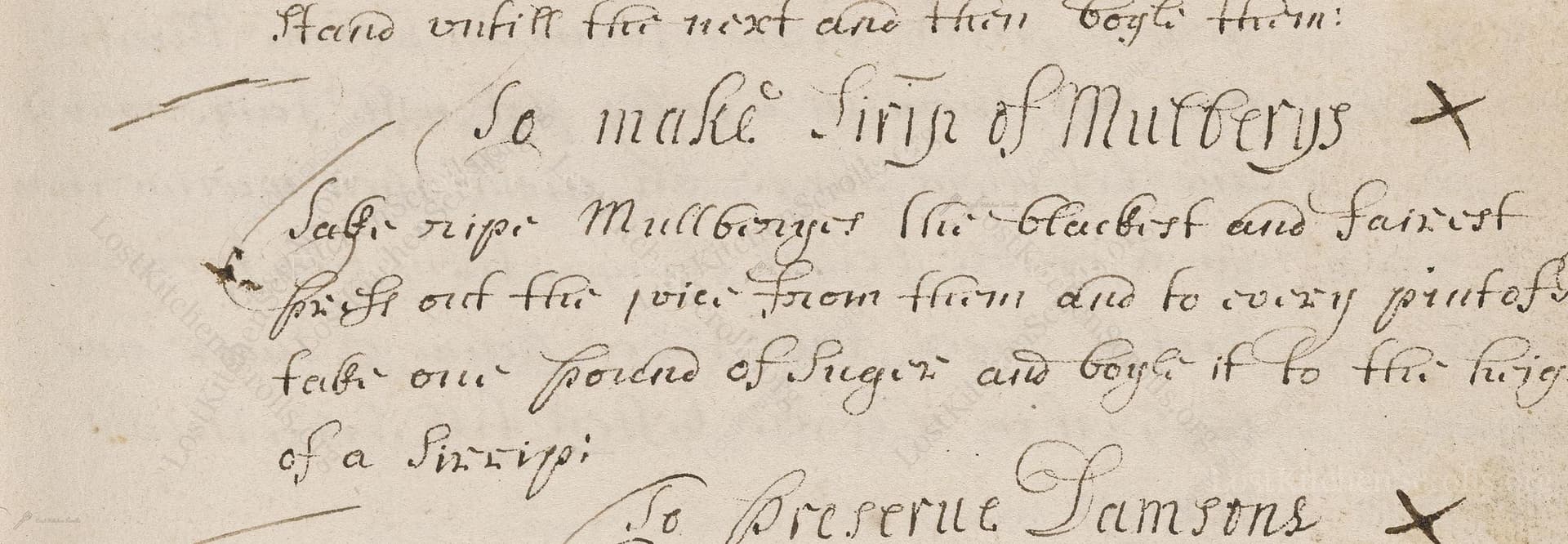
To Make Sirip Of Mullberrys
"Take ripe Mullberrys the blackest and fairest press out the Juce from them and to every pint of Juce take one pound of Sugar and Boyle it to the height of a Sirrip."
Note on the Original Text
This recipe is written in the succinct, almost shorthand style of historic household manuscripts. Instructions assume prior kitchen knowledge and omit many details modern cooks expect. Spelling is unstandardized: 'Sirip' is an old-fashioned variant of 'syrup', and 'Boyle' here means to simmer and reduce. Quantities are given in pints and pounds – the cook would be expected to adjust quantities intuitively. The focus is on ratio and end result, not precise timings or temperatures.

Title
Cookery book of Ann Goodenough (1738)
You can also click the book image above to peruse the original tome
Writer
Ann Goodenough
Era
1738
Publisher
Unknown
Background
A delightful journey into the kitchens of early 18th-century England, this collection captures the flair and flavors of its time with recipes crafted by the inventive Ann Goodenough. Expect a charming medley of hearty roasts, comforting pies, and time-honored confections, perfect for those wishing to dine as they did in Georgian days.
Kindly made available by
Folger Shakespeare Library
This syrup recipe comes from the early to mid-18th century, attributed to Ann Goodenough, a woman likely involved in domestic management and medicinal household crafts during the years 1700 to 1775. Recipes like this were prized for preserving fruits and creating healthful cordials, as mulberries were believed to have cooling and medicinal properties, making them a household staple for summer ailments. The abundance of sugar in 18th-century English kitchens – still a luxury, but increasingly accessible to the middle classes – allowed for sweet preserves such as syrups and compotes. The recipe reflects domestic ingenuity and the importance of detailed, practical knowledge among women cookery writers of the period.

In the 18th century kitchen, you would use a large ceramic or wooden bowl for crushing and collecting the mulberries, a linen or muslin cloth for straining the juice, a brass or copper preserving pan suspended over the hearth for boiling, and a wooden spoon for stirring. Bottles would be sterilized by rinsing with scalding water or hot spirits, then stoppered with waxed corks or parchment.
Prep Time
10 mins
Cook Time
15 mins
Servings
16
We've done our best to adapt this historical recipe for modern kitchens, but some details may still need refinement. We warmly welcome feedback from fellow cooks and culinary historians — your insights support the entire community!
Ingredients
- Fresh ripe black mulberries (approx. 2 1/4 lbs to yield about 2 cups juice)
- 2 cups granulated sugar (white sugar; historically, they may have used loaf sugar or unrefined cane sugar)
Instructions
- To make Mulberry Syrup with a modern twist, begin by taking fresh, ripe black mulberries – the darker and more uniform, the better for both flavor and color.
- Rinse and gently mash them to release the juice, then strain through a fine sieve or muslin cloth to remove seeds and pulp.
- Measure the juice.
- For every 2 cups of mulberry juice, use 2 cups of granulated sugar.
- Combine both in a saucepan.
- Heat gently, stirring until the sugar dissolves, then bring to a boil.
- Let it simmer and reduce until the syrup thickens slightly—it should just coat the back of a spoon.
- Skim off any foam.
- Once thickened (you are aiming for a pourable syrup with a silky texture), let it cool and bottle in sterilized glass bottles.
- Store in the refrigerator for several weeks.
Estimated Calories
110 per serving
Cooking Estimates
Preparing mulberry syrup takes about 10 minutes to wash, mash, and strain the berries, then another 15 minutes to cook and thicken the syrup. Each serving is a sweet, rich syrup perfect for drinks or desserts, and the calories listed are for a typical 30ml (2 tablespoon) serving.
As noted above, we have made our best effort to translate and adapt this historical recipe for modern kitchens, taking into account ingredients nowadays, cooking techniques, measurements, and so on. However, historical recipes often contain assumptions that require interpretation.
We'd love for anyone to help improve these adaptations. Community contributions are highly welcome. If you have suggestions, corrections, or cooking tips based on your experience with this recipe, please share them below.
Join the Discussion
Rate This Recipe
Dietary Preference
Main Ingredients
Culinary Technique

Den Bockfisch In Einer Fleisch Suppen Zu Kochen
This recipe hails from a German manuscript cookbook compiled in 1696, a time whe...

Die Grieß Nudlen Zumachen
This recipe comes from a rather mysterious manuscript cookbook, penned anonymous...

Ein Boudain
This recipe comes from an anonymous German-language manuscript cookbook from 169...

Ein Gesaltzen Citroni
This recipe, dating from 1696, comes from an extensive anonymous German cookbook...
Browse our complete collection of time-honored recipes



